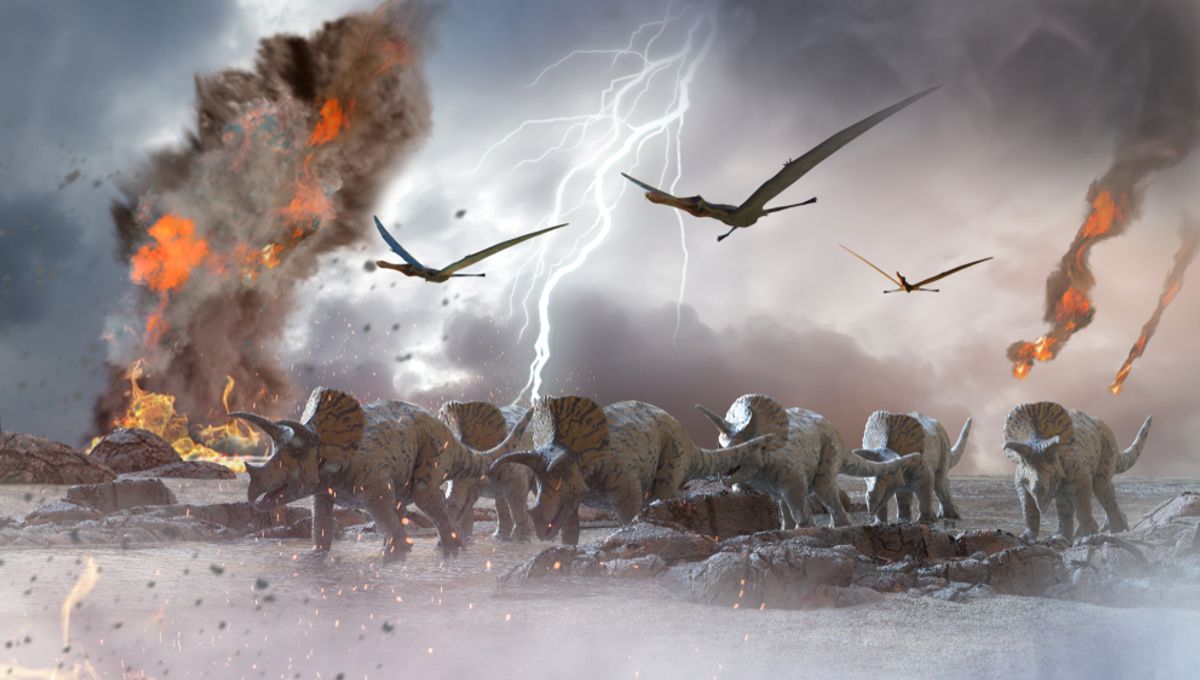
The discovery of fossils apparently killed on the very day the dino-killing asteroid hit stands as one of the most astonishing scientific discoveries of the century. The most significant follow-up so far has been two papers that independently analyzed the site and concluded the event occurred in late spring or summer in the Northern Hemisphere. Yet according to the lead author of one of those papers, the other team faked their data in order to beat her to publication.
The explosive allegation reveals a side to scientific research few non-scientists see. Concerns about scientific misconduct usually center, understandably, on work that reaches false conclusions, for example to bolster the profits of companies.
However, if Melanie During is right in a statement made on the website PubPeer, there is nothing wrong with Robert DePalma’s conclusion. After all, it’s pretty much identical to her own. Her issue is with how DePalma – who led the discovery of and oversees the famed fossil Tanis site in North Dakota – got there.
PubPeer is a website where scientists can provide feedback on published work. It’s a way of making peer review a more open and extensive process, rather than relying on two reviewers who happen to be chosen by a journal editor to pick up any problems.
During is a student at Uppsala University. For her PhD she examined fossils from the Tanis deposit, where specimens show signs of having died in a tsunami-like event, followed by burial in ash and glass from an asteroid impact. During and her co-authors published a paper in Nature in February revealing growth patterns in the ears of fish killed at Tanis indicate the season of their death.
Such a discovery would normally be enough to make an aspiring young scientist’s reputation and set them on the path to career success. However, two months earlier DePalma, previously a collaborator with During, had published something similar in Scientific Reports.
DePalma’s work was not as precise as During’s. DePalma had claimed the event could have occurred in spring or summer, while During narrowed it down saying: “The feeding season had not yet climaxed – death came in spring.”
Nevertheless, in the aftermath of DePalma’s paper, her work looked like a refinement, not a breakthrough.
However, During and colleagues allege DePalma lacked the evidence to make his claim. “Primary data are not provided, the lab where the analyses were performed is not specified, and the methods are insufficiently described,” they write. The authors claim their efforts to obtain the data, or evidence the research was done, has met with no response, and year-long complaints to Scientific Reports led to a promise of investigation that appears not to have been fulfilled.
The evidence provided in DePalma’s paper contains missing data points and contradictory error bars. ”Since these observations are uncharacteristic for genuine biological data, we are compelled to ask whether the data may be fabricated,” During and colleagues write.
If DePalma didn’t have the fossils to reach his conclusion, how did he get the answer right? During believes he was aware of her findings. Besides their correspondence on the topic (DePalma was originally going to be one of During’s co-authors), During’s work was posted online as a preprint. DePalma’s work was submitted later, but published first.
DePalma, with a global reputation built on the original paper introducing Tanis to the world, denies the allegations. “We absolutely would not, and have not ever, fabricated data and/or samples to fit this or another team’s results,” he told Science. He blames the absence of raw data on the death of a collaborator, and not being able to recover items from the laboratory where the analysis was done.
Nevertheless, DePalma’s paper does show signs it was, at minimum, rushed to publication, with the sort of errors peer review and editorial processes usually pick up in a publication as prestigious as Scientific Reports.
“Something is fishy here,” the University of Regina’s Professor Mauricio Barbi, who was not involved with either paper, told Science after they asked him to look at DePalma’s work. Apparently, he didn’t mean the dead paddlefish and sturgeons found at Tanis.
If During’s allegations are substantiated the implications could be wider than a single paper, however significant. The Tanis deposit, by far the most important site in palaeontology today, is on private land. DePalma holds the lease and can determine which scientists get to study it. When people talk about gatekeeping in science, they usually don’t mean it so literally.
If DePalma, who is working on a PhD at Manchester University, is capable of the sort of fraud During alleges, his hold over Tanis becomes alarming. There are notorious examples of palaeontologists jealously guarding specimens and sites from potential rivals, but nothing as significant as Tanis.
An additional irony to the story is that Scientific Reports, who During accuses of failing to investigate her complaints seriously, is a publication of Springer Nature, in whose flagship journal During’s work appeared two months later.
Conspiracy theorists present a world where a scientific establishment is united to deceive the general public. The internal disputes amongst scientists, and even between journals in the same publishing house, tell a very different story.
DePalma’s paper is open access at Scientific Reports, as is During’s in Nature. The allegations are set out in detail at PubPeer.
Source Link: Cheating Accusations Challenge Paper Revealing The Season The Dinosaurs Died